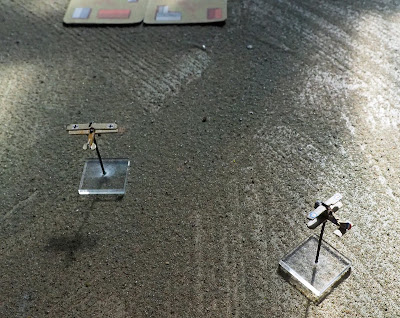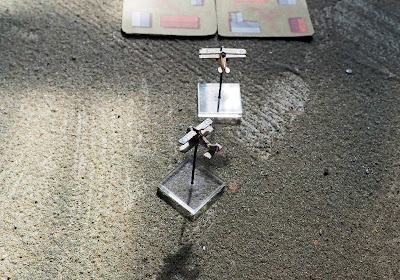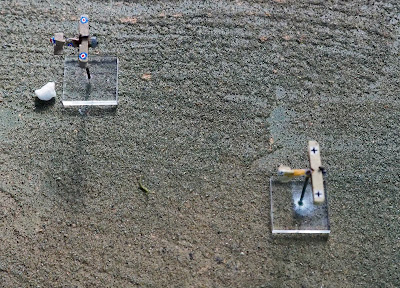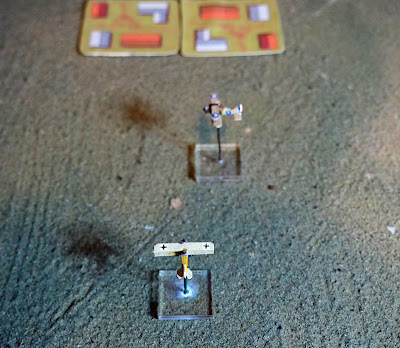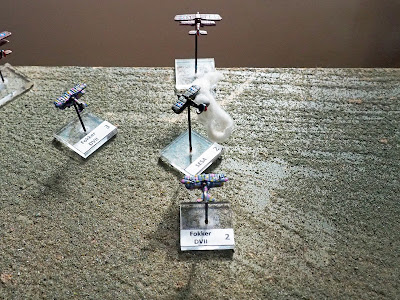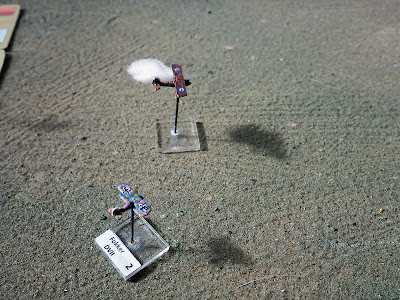I played a couple of small games of 'Spandau and Lewis' during the week in order to try out my new initiative system, and started to feel that, whilst it doesn't have the clutter of dice next to the aircraft reminding me which one is to move next, it doesn't quite cut it as a system.
So today I decided to play
last week's scenario with the old system, just to see how I felt about it. And, to be honest, I felt OK with it.
As you will recall the setup is a couple of RE8s heading off on a photographic mission, and three Fokker DVIIs attacking them. The RE8s are supported by a couple of SE5s.
I rolled for pilot quality in this one. The British didn't do well, with a rookie crew in one of the RE8s, and a rookie pilot in one of the SE5s. The Germans got an ace.
Opening approached, with the initiative dice in place.
Obviously everything piled into the centre for the first pass. Every plane got a shot at something, but surprisingly little damage was inflicted.
The German ace got in a shot at an RE8, but his guns jammed.
The RE8s approached the target, but a DVII followed them, and they took hits as they got their photos.
One Se5 had misjudged its approach and was turning back into the fight. But the novice SE5 pilot got on the tail of a DVII and scored some damage.
The lead RE8 was now under pressure from the tailing DVII.
Unable to turn tight enough, it flew off the table, forcing me to write some rules for what happens when aircraft fly off the table. I'll put them at the end. Spoiler: They get to come back. Possibly.
The other RE8 also looked certain to leave the board. Both of them were now seriously shot up.
The novice SE5 pilot had done a great job in staying locked onto the lead DVII, and fired a burst which ;eft it close to disintegrating. But another DVII got in behind the unfortunate British pilot and shot him down.
With both RE8s currently out of the action, a lone SE5 now faced all three DVIIs. The ace was, in fact, badly out of position after clearing his guns, but the other two quickly turned on the British plane. It survived their attack, damaging one of the Germans ...
... and got onto the tail of the other, as one of the RE8s returned, making a run for home. The damaged DVII turned sharply out of the fight to avoid the SE5 ...
... and flew straight into the sights of the tail-gun on the RE8. He went down in flames.
The German ace cut in from the other side, and put some bullets through the RE8, but his guns jammed again.
It was left to the other DVII to shoot down the RE8, but not before the observer scored massive damages on his plane.
The SE5 came under attack from the ace, who once again had cleared his guns, but escaped serious damage.
The second RE8 was now heading for home, and with the escorting SE5 temporarily chased away from the fight was an easy target for the German ace. Or would have been had the pilot not misjudged a couple of turns and couldn't line up a shot.
But the second DVII came in for a shot. The observer on the RE8 fired at the same time as the German, and both planes fell apart in the sky.
This left just one DVII and one SE5, at opposite ends of the board, so I assumed that both planes simply turned for home.
The Germans had shot down both two-seaters, but at the cost of two DVIIs, so whilst it was a win for them, it was a costly one.
The initiative worked much better in this game, with the novice pilots sometimes able to outwit their more experienced foes. The British rolled quite badly, even allowing for the slight edge the Germans had with their more nimble machines. It should be noted that both German casualties were caused by the two-seaters, and the bulk if the damage on the Germans was inflicted by the two novice crews.
As for flying off the table, I ruled that having done so, the plane had to stay off for the whole of the next turn. On the turn after that I rolled a D6 before initiative was determined:
0 or less - Plane is lost
1-2 - The plane does not return this turn. Roll again next turn.
3-5 - The plane re-enters the table 1D3" to the left (1-3) or right (4-6) of where it left.
6+ - The plane reenters the table up to 3" away from the point where it left the table (player's choice)
Modifiers
+1 - Ace pilot
-1 - Novice pilot
-1 - Plane has take at least half hits
+1 - Left own home edge
-1 - Left opponent's home edge
Note that each side will have a 'home' edge, normally the one they should exit before the end of the scenario. I normally run each scenario to a turn limit, and at least some of the planes are required to exit their home edge before the end of the game. So being delayed by being off-table can be a real problem.
I have also started to think about modifying the critical hits table slightly. At the moment this is set up such that a critical will pretty much down most planes if it happens, but I thought maybe a little more nuance was possible, without bogging the game down in too much bookkeeping.











